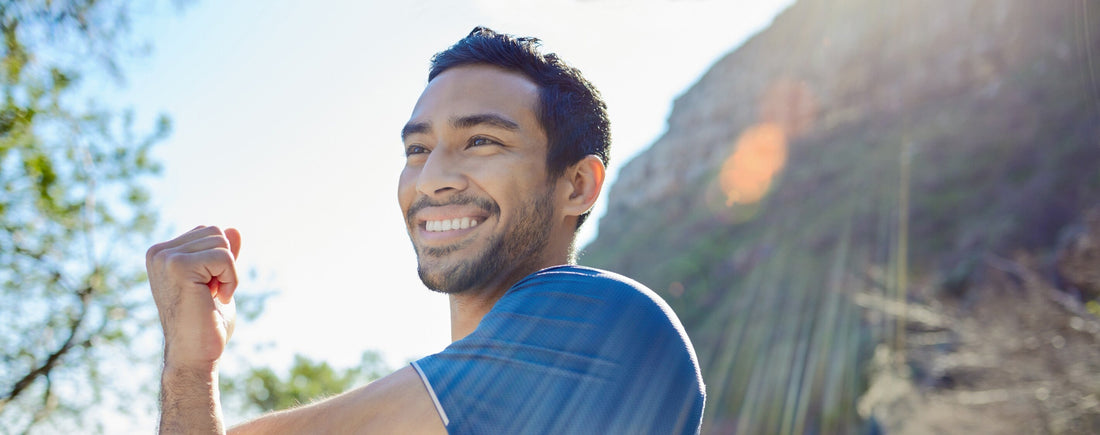The potential to move the body as a form of medicine is a tremendous gift we should enjoy on a daily basis. Exercise or vyāyāma, in Sanskrit, is an important part of a complete Ayurvedic daily regimen, called dinacaryā. According to Charaka, an ancient Ayurvedic scholar, “Physical movements which increase stability and strength and are done in the right quantity are considered exercise” (Cā.Sū.7). Regular physical activity helps us maintain the tone, power, and coordination of the body. Exercise strengthens all seven tissues of the body, and it opens and activates the channels our body uses to maintain homeostasis. While working out, breathing exercises called prāṇāyāma can effortlessly happen, which contribute to overall longevity. Exercise regulates the metabolic fires of the body to ensure that the body is actively eliminating impurities through sweat and other waste carrying channels.
Each dosha type can customize their workout style to meet the needs of their individual psychophysiology. Vata people (or those experiencing a temporary Vata-imbalance) can favor slow, steady, gentle forms of exercise like tai chi, restorative yoga, walking, Pilates, and free weights. Vatas should focus on building muscles and adding strength to fill out their delicate frame while protecting dry joints and stretching out any rigidity. Pitta people can favor sports that allow them to exert without overheating, such as swimming, snowboarding, surfing, kayaking, and team sports (to avoid self-criticism, laugh, and not take life too seriously). Pittas tend to be independent, self-starting athletes but should take care not to overdo the intensity or get injured in extreme sports. Kaphas need workouts that will clear the lungs, get the heart pumping, and induce sweating. Jogging, running, jumping rope, spinning classes, and any activity that involves lots of cardio and high energy is great for Kaphas. They might need an extra push to get going, so joining a club or group for accountability and motivation is great.
Lifecycles can be considered in the amount and type of movement one choses. Children are in their Kapha lifecycle, so it is important for them to get outside, run around, and breathe plenty of fresh air to expend their abundant energy. Puberty to age 55 is considered Pitta lifecycle, so getting outdoors in beautiful nature landscapes and participating in team sports can balance Pittas by helping them destress from the responsibilities and demands of life while staying active. Fifty-five and onwards is Vata lifecycle, so people in this category will easily lose strength, coordination, and bone density if they do not move enough, but they should keep their exercises mellow and safe to avoid injury and overexertion. Lifecyle and dosha type can all be considered when choosing a movement style that works best. If the mind is in balance, we naturally gravitate towards movement forms that are beneficial for us. Making sure our dietary needs for our dosha type are met is an important aspect of optimal performance in athleticism.
In the morning during the Kapha-time of day (between 6am-10am) is the best time frame to fit in a workout. The body has been resting and needs a boost of exertion to warm up, get blood flowing, breath, wake up, and jump start digestive fire. When the body is not used to the habit of getting up and exercising, there will be resistance and difficulty in getting started. This is because the Kapha time of day makes it so easy to be slow, sleepy, and still—which is exactly why it’s important to get going at that time. By practicing the law of opposite during the Kapha time –inviting in qualities of heat, lightness, and mobility – we can prevent excess Kapha from accumulating due to oversleep or lethargy. Once a routine is set, the body will program itself to naturally get started.
Like everything in Ayurveda, there are optimal and less ideal times for workouts. When we exercise during the Pitta hours of the day (10am-2pm, especially in the middle of summer), this can increase our Pitta, causing us to feel overheated, sunburnt, and depleted. On the flip side, working out too late or right before bedtime might cause restlessness and insomnia, as working out boosts energy levels. Physical exertion right after eating may cause indigestion, as blood and energy are being sent from the koṣṭha (internal organs) to the Śākhā (extremities and skeletal muscles). Seasonally, it is better to work out harder during the cooler months of the year, to maintain circulation and body heat and to avoid depletion and burnout during hot Pitta months. Rest is best when ill or overly fatigued, so not respecting the body’s need to recover can result in decreased ojas, or immune function.
There is a sutra which says: “Half energy capacity can be exerted during exercise by strong individuals who eat a rich diet. Such exercise can be done during the cold seasons, while slower exercises can be done during other times of year. (Va. Su. 2)
The recommended quantity of exercise exertion, as stated in this classical sutra, is “Śaktyardha” which means “to half the strength” of the person. This capacity can change according to individual constitution, age, and current level of fitness. From an Ayurvedic standpoint, it is ideal to exercise on a daily basis to half-capacity, until a thin layer of sweat accumulates on the forehead. This leaves the body feeling energized and limber, in contrast to the irregularity of doing no exercise a few days a week, then exerting full strength a few days a week for hours at the gym, which could lead to bulkiness, injury, and fatigue. The body needs daily movement for oxygenation, circulation, coordination, and agility, while conserving enough energy to go about our daily duties.
The Chopra system includes three categories of exercise to maintain a healthy, energetic body: strength, cardio, and flexibility. Free weight training, calisthenics, walking, jogging, stretching, and daily yoga practice are easy ways to incorporate all three types of movement into our daily routine. If your current regimen leans more towards only one of the three categories, you can remember to integrate the other two before or after a workout. For example, runners can strength train their upper body, which may get less attention than their lower body cardio-focus. Rock climbers can remember to stretch after getting “pumped” on the wall, to be less tight and sore the next day, and yogis can protect their tendons and ligaments by building healthy muscle strength around major joints to avoid overstretching.
Underdoing it with exercise can lead to tamas (the feeling of heaviness or inertia), increased āma (toxicity), Kapha accumulation, lethargy, laziness, and stress. Much of the developed world works more with their minds than their bodies, so when the body sits still for too long, anxious energy can stagnate in the mind if it is not released physically.
Overdoing it in exercise can lead to fatigue, burnout, joint damage (knees, wrists, sprain or injury), an increase in Vata and Pitta doshas, and an angry or overly competitive demeanor. Being in tune with and respecting the body’s physical limitations is an important aspect of the relationship we have with ourselves. While ill, overworked, exhausted, injured, menstruating, pregnant, or very elderly it is best to read, rest, relax, nurture and practice non-violence to oneself. Allowing space and stillness for proper recovery can be quite the challenge, especially for stubborn and rajasic Pitta-minded athletes.
Sattvic (harmonious) workouts mean doing the right movement at the right time for the right person, with awareness. Practicing exercise with proper timing, quantity, and style will result in self-confidence, high energy levels, good strength, tone, coordination, and the ability to maintain a stable body weight ideal for one’s frame and prakruti type (Vatas will bulk up, Kaphas will slim out, and Pittas will maintain muscular tone). Proper training also results in sharp mental alertness, oxygenized tissues, longevity, prowess and skill in sports, a positive attitude with teammates or opponents, good quality sleep at night, good posture, and enjoyment of the sport or exercise activity.
Movement should be mindful. Exercise is an excellent opportunity to connect mind, breath, body, and spirit. It means checking out with our intellectual pursuits of the day to check in with ourselves, whether it is alone, with family, nature, or teammates. When the body moves blindly without engagement of the brain, only muscles are nourished. When the body moves with mind, injury is prevented through proper posture and skeletal alignment, while coordination and skill are increased. When body and mind move with breath, prana is nourished on a cellular level, promoting wellness, focus, and mind-body awareness. When body, mind, breath, and spirit all work together, joy results, and one feels strong and happy during and after a workout.
Body image is difficult to avoid in the context of fitness clubs and media. It is important not to compare one’s individual body type to others in a judgmental way. The body is the temple of the soul, and each one is unique and special in form and function. If we look beyond mainstream trends, we can view each body with the non-judgmentalism of pure, passive, awareness to recognize the beauty in all shapes and forms. The yogic term ahiṃsā, nonviolence to self and others, means not abusing oneself to achieve unrealistic physical results. When the body is healthy and filled with love, attractiveness of our physical form will emanate from internal to external radiance.
It is pertinent to love our body as the vessel for our existence, without becoming overly attached to it. Overattachment to the physical body will result in distress when the physical body inevitably changes. Exercise is essential in maintaining good health, while keeping in mind the wisdom that the soul is the eternal while the physical body is temporary, therefore it is beneficial to take a moment to be still and look internally after exercise to remind yourself who you are. Our physically fit soul-temple can be used to express, serve, and love in its individual and unique style to fulfill its purpose in the world. How we workout and with whom can be an important part of our wellbeing, identity, personality expression, and recreation. Whether it is in Savasana on the yoga mat or a brief pause at the peak of a mountain, connecting with the internal source of infinitely inexhaustible strength will provide the endurance to face all life’s challenges.
Transform your health and discover a personalized approach to well-being at the Chopra Health Retreat. A 6-day immersive program rooted in the ancient wisdom of Ayurveda.
Personalize your Workout Style
Each dosha type can customize their workout style to meet the needs of their individual psychophysiology. Vata people (or those experiencing a temporary Vata-imbalance) can favor slow, steady, gentle forms of exercise like tai chi, restorative yoga, walking, Pilates, and free weights. Vatas should focus on building muscles and adding strength to fill out their delicate frame while protecting dry joints and stretching out any rigidity. Pitta people can favor sports that allow them to exert without overheating, such as swimming, snowboarding, surfing, kayaking, and team sports (to avoid self-criticism, laugh, and not take life too seriously). Pittas tend to be independent, self-starting athletes but should take care not to overdo the intensity or get injured in extreme sports. Kaphas need workouts that will clear the lungs, get the heart pumping, and induce sweating. Jogging, running, jumping rope, spinning classes, and any activity that involves lots of cardio and high energy is great for Kaphas. They might need an extra push to get going, so joining a club or group for accountability and motivation is great.
Lifecycles can be considered in the amount and type of movement one choses. Children are in their Kapha lifecycle, so it is important for them to get outside, run around, and breathe plenty of fresh air to expend their abundant energy. Puberty to age 55 is considered Pitta lifecycle, so getting outdoors in beautiful nature landscapes and participating in team sports can balance Pittas by helping them destress from the responsibilities and demands of life while staying active. Fifty-five and onwards is Vata lifecycle, so people in this category will easily lose strength, coordination, and bone density if they do not move enough, but they should keep their exercises mellow and safe to avoid injury and overexertion. Lifecyle and dosha type can all be considered when choosing a movement style that works best. If the mind is in balance, we naturally gravitate towards movement forms that are beneficial for us. Making sure our dietary needs for our dosha type are met is an important aspect of optimal performance in athleticism.
Timing is Everything
In the morning during the Kapha-time of day (between 6am-10am) is the best time frame to fit in a workout. The body has been resting and needs a boost of exertion to warm up, get blood flowing, breath, wake up, and jump start digestive fire. When the body is not used to the habit of getting up and exercising, there will be resistance and difficulty in getting started. This is because the Kapha time of day makes it so easy to be slow, sleepy, and still—which is exactly why it’s important to get going at that time. By practicing the law of opposite during the Kapha time –inviting in qualities of heat, lightness, and mobility – we can prevent excess Kapha from accumulating due to oversleep or lethargy. Once a routine is set, the body will program itself to naturally get started.
Like everything in Ayurveda, there are optimal and less ideal times for workouts. When we exercise during the Pitta hours of the day (10am-2pm, especially in the middle of summer), this can increase our Pitta, causing us to feel overheated, sunburnt, and depleted. On the flip side, working out too late or right before bedtime might cause restlessness and insomnia, as working out boosts energy levels. Physical exertion right after eating may cause indigestion, as blood and energy are being sent from the koṣṭha (internal organs) to the Śākhā (extremities and skeletal muscles). Seasonally, it is better to work out harder during the cooler months of the year, to maintain circulation and body heat and to avoid depletion and burnout during hot Pitta months. Rest is best when ill or overly fatigued, so not respecting the body’s need to recover can result in decreased ojas, or immune function.
On Quantity and Quality
There is a sutra which says: “Half energy capacity can be exerted during exercise by strong individuals who eat a rich diet. Such exercise can be done during the cold seasons, while slower exercises can be done during other times of year. (Va. Su. 2)
The recommended quantity of exercise exertion, as stated in this classical sutra, is “Śaktyardha” which means “to half the strength” of the person. This capacity can change according to individual constitution, age, and current level of fitness. From an Ayurvedic standpoint, it is ideal to exercise on a daily basis to half-capacity, until a thin layer of sweat accumulates on the forehead. This leaves the body feeling energized and limber, in contrast to the irregularity of doing no exercise a few days a week, then exerting full strength a few days a week for hours at the gym, which could lead to bulkiness, injury, and fatigue. The body needs daily movement for oxygenation, circulation, coordination, and agility, while conserving enough energy to go about our daily duties.
The Chopra system includes three categories of exercise to maintain a healthy, energetic body: strength, cardio, and flexibility. Free weight training, calisthenics, walking, jogging, stretching, and daily yoga practice are easy ways to incorporate all three types of movement into our daily routine. If your current regimen leans more towards only one of the three categories, you can remember to integrate the other two before or after a workout. For example, runners can strength train their upper body, which may get less attention than their lower body cardio-focus. Rock climbers can remember to stretch after getting “pumped” on the wall, to be less tight and sore the next day, and yogis can protect their tendons and ligaments by building healthy muscle strength around major joints to avoid overstretching.
Underdoing it with exercise can lead to tamas (the feeling of heaviness or inertia), increased āma (toxicity), Kapha accumulation, lethargy, laziness, and stress. Much of the developed world works more with their minds than their bodies, so when the body sits still for too long, anxious energy can stagnate in the mind if it is not released physically.
Overdoing it in exercise can lead to fatigue, burnout, joint damage (knees, wrists, sprain or injury), an increase in Vata and Pitta doshas, and an angry or overly competitive demeanor. Being in tune with and respecting the body’s physical limitations is an important aspect of the relationship we have with ourselves. While ill, overworked, exhausted, injured, menstruating, pregnant, or very elderly it is best to read, rest, relax, nurture and practice non-violence to oneself. Allowing space and stillness for proper recovery can be quite the challenge, especially for stubborn and rajasic Pitta-minded athletes.
Sattvic (harmonious) workouts mean doing the right movement at the right time for the right person, with awareness. Practicing exercise with proper timing, quantity, and style will result in self-confidence, high energy levels, good strength, tone, coordination, and the ability to maintain a stable body weight ideal for one’s frame and prakruti type (Vatas will bulk up, Kaphas will slim out, and Pittas will maintain muscular tone). Proper training also results in sharp mental alertness, oxygenized tissues, longevity, prowess and skill in sports, a positive attitude with teammates or opponents, good quality sleep at night, good posture, and enjoyment of the sport or exercise activity.
Beyond the Body
Movement should be mindful. Exercise is an excellent opportunity to connect mind, breath, body, and spirit. It means checking out with our intellectual pursuits of the day to check in with ourselves, whether it is alone, with family, nature, or teammates. When the body moves blindly without engagement of the brain, only muscles are nourished. When the body moves with mind, injury is prevented through proper posture and skeletal alignment, while coordination and skill are increased. When body and mind move with breath, prana is nourished on a cellular level, promoting wellness, focus, and mind-body awareness. When body, mind, breath, and spirit all work together, joy results, and one feels strong and happy during and after a workout.
Body image is difficult to avoid in the context of fitness clubs and media. It is important not to compare one’s individual body type to others in a judgmental way. The body is the temple of the soul, and each one is unique and special in form and function. If we look beyond mainstream trends, we can view each body with the non-judgmentalism of pure, passive, awareness to recognize the beauty in all shapes and forms. The yogic term ahiṃsā, nonviolence to self and others, means not abusing oneself to achieve unrealistic physical results. When the body is healthy and filled with love, attractiveness of our physical form will emanate from internal to external radiance.
It is pertinent to love our body as the vessel for our existence, without becoming overly attached to it. Overattachment to the physical body will result in distress when the physical body inevitably changes. Exercise is essential in maintaining good health, while keeping in mind the wisdom that the soul is the eternal while the physical body is temporary, therefore it is beneficial to take a moment to be still and look internally after exercise to remind yourself who you are. Our physically fit soul-temple can be used to express, serve, and love in its individual and unique style to fulfill its purpose in the world. How we workout and with whom can be an important part of our wellbeing, identity, personality expression, and recreation. Whether it is in Savasana on the yoga mat or a brief pause at the peak of a mountain, connecting with the internal source of infinitely inexhaustible strength will provide the endurance to face all life’s challenges.
Transform your health and discover a personalized approach to well-being at the Chopra Health Retreat. A 6-day immersive program rooted in the ancient wisdom of Ayurveda.






















